 Food
Food  Food
Food  History
History 10 Odd Things Colonial Americans Kept at Home
 Weird Stuff
Weird Stuff 10 Superstitious Beliefs That Once Consumed Entire Cultures
 History
History 10 Bizarre Friendly Fire Incidents in Military History
 Technology
Technology 10 Modern Technologies That Accidentally Imitate Ancient Magic
 Mysteries
Mysteries 10 Mysteries of the Human Genome
 Weird Stuff
Weird Stuff 10 Things So Rare They’ve Only Been Found Once
 History
History 10 Legends Whose Last Moments Undid Their Glory
 Health
Health 10 Futuristic Ideas to Treat Common Medical Problems
 Weird Stuff
Weird Stuff Ten Surreal Attempts to Reverse Baldness
 Food
Food 10 Everyday Foods You Didn’t Know Were Invented by the U.S. Military
 History
History 10 Odd Things Colonial Americans Kept at Home
 Weird Stuff
Weird Stuff 10 Superstitious Beliefs That Once Consumed Entire Cultures
Who's Behind Listverse?

Jamie Frater
Head Editor
Jamie founded Listverse due to an insatiable desire to share fascinating, obscure, and bizarre facts. He has been a guest speaker on numerous national radio and television stations and is a five time published author.
More About Us History
History 10 Bizarre Friendly Fire Incidents in Military History
 Technology
Technology 10 Modern Technologies That Accidentally Imitate Ancient Magic
 Mysteries
Mysteries 10 Mysteries of the Human Genome
 Weird Stuff
Weird Stuff 10 Things So Rare They’ve Only Been Found Once
 History
History 10 Legends Whose Last Moments Undid Their Glory
 Health
Health 10 Futuristic Ideas to Treat Common Medical Problems
 Weird Stuff
Weird Stuff Ten Surreal Attempts to Reverse Baldness
10 Zombies of the Insect World
According to reliable sources, the zombie apocalypse is fast approaching. But, just like with so many other things, Mother Nature is already two steps ahead of us when it comes to zombies. We’ve talked about some bizarre cases of mind control in animals and insects in the past, but if there’s one thing nature knows best, it’s unspeakable horror. Here are 10 more examples of insect zombies and the fascinating ways parasitic organisms take over the lives—and minds—of their hosts.
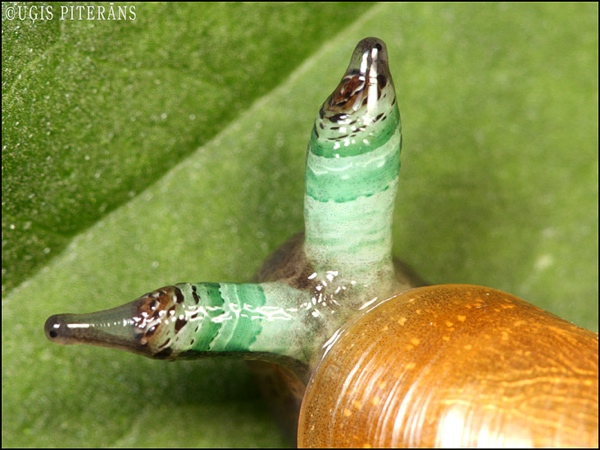
Parasite: Leucochloridium paradoxum
The life of a snail isn’t exactly glamorous, but they make the best of it—their shells make them difficult to eat, they’re evolutionarily wired to avoid sunlight and open spaces where predators might be lurking, and their slime coating makes them unappetizing to most predators anyway. But when amber snails fall into the zombie grip of the Leucochloridium paradoxum flatworm, their lives turn into what might be the most excruciating existence in the invertebrate world.
The green-banded broodsac, as the parasite is commonly known, lives its adult life in bird intestines, laying eggs that make their way into the bird droppings. With any luck, a snail will stumble across one of those droppings, eat it, and the nightmare will begin. When the flatworm eggs are safely inside the snail, they hatch into miracidia, or larva, and spread through the digestive tract, where they’ll grow into sporocysts. Sporocysts are thick, swollen tubes—broodsacs—that hollow out the eyestalks of the snail and begin pumping flatworm juveniles into the empty space.
At this point the snail is completely blind, and loses its natural fear of sunlight—exactly what the flatworms need to complete their life cycle. When sunlight hits the colorful broodsacs in the eyestalks, they begin to twitch and pulsate—the brighter the light, the more they twitch—making them look exactly like a caterpillar to attract birds. If the snail is lucky the bird will eat it whole. If not, the bird will simply rip off the eyestalk. Eventually the stalk grows back, and the cycle continues over and over until the snail finally dies.
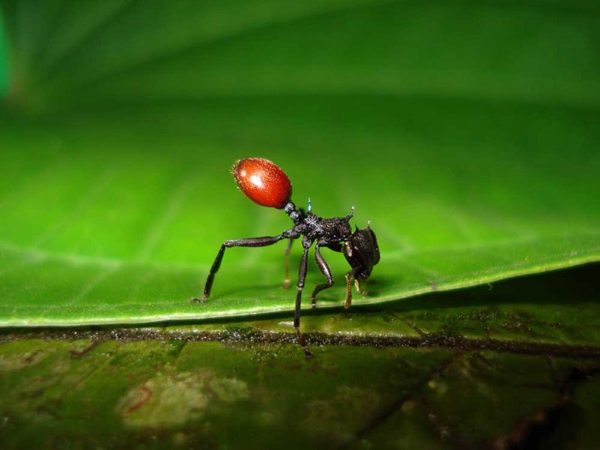
Parasite: Myrmeconema neotropicum
Giant gliding ants live in the rainforest canopy of Central America, making their nests in the treetops as high as 130 feet (40 m) over the forest floor. An ant that falls to the floor is pretty much guaranteed to die before making its way back to the colony, so over the years they’ve developed a unique trait—they can glide, flying squirrel style, back to a tree trunk.
It was during a trip to Panama to study this unusual feature in 2005 that scientists noticed something else—the gasters (rear ends) of some of these ants (which are naturally black) would inexplicably turn bright red, and the ant would then thrust its gaster into the air. So they dissected one of the ants and found that the gaster was crammed full of parasitic nematode eggs which were doing several things to the ants.
First of all, a chemical created by the eggs would cause the ant to stop releasing pheromones and force it to move in a slow, shambling walk with its gaster high in the air. Second, it thinned the exoskeleton over the gaster so the red eggs would be visible through the ant’s shell, giving it that bright red coloring…which is nearly identical to berries that are commonly eaten by birds in the area. Put it all together, and you have a nearly immobile, delicious looking ant ready to be picked off by a bird. The nematode then infects the bird and lays more eggs, which are dropped off in its feces and eaten by another ant colony in a different part of the forest, spreading the parasite.
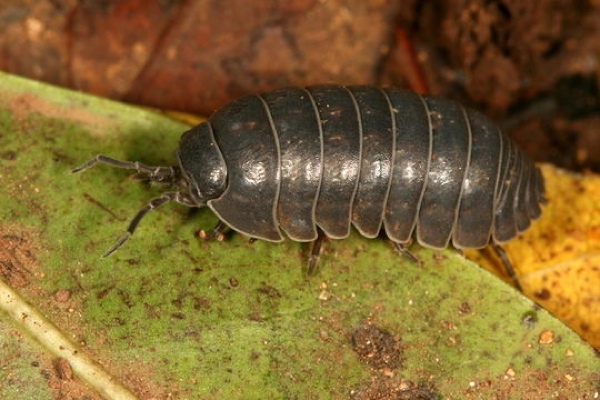
Parasite: Acanthocephala
Parasites that forcibly change the behavior of their hosts do it for one of two reasons—either to protect the host, or to make it more vulnerable so the parasite can continue its life cycle in another species. Acanthocephala worms do the latter, turning several species—especially pill bugs—into mindless vehicles that will carry them to their true hosts, European starlings.
Pill bugs like dark, damp spaces. If you turn over a log in the summer, you’ll probably see a few dozen of the little critters scattering away from the light. Pill bugs infected with acanthocephalan, though, do the opposite—they become positively phototactic, or attracted to the light, even though going into the open is a definite recipe for death. Even more bizarre, the parasite makes pill bugs prefer lighter surfaces, which makes it easier for starlings to spot them from above. The parasite shuts off all the pill bugs’ defense mechanisms and draws it into dangerous environments.
Slightly unrelated, after two adult acanthocephala worms mate (they’re in a bird at this point), the male will secrete a cement-like substance that glues shut the female’s vagina, preventing her from mating with any other worms.
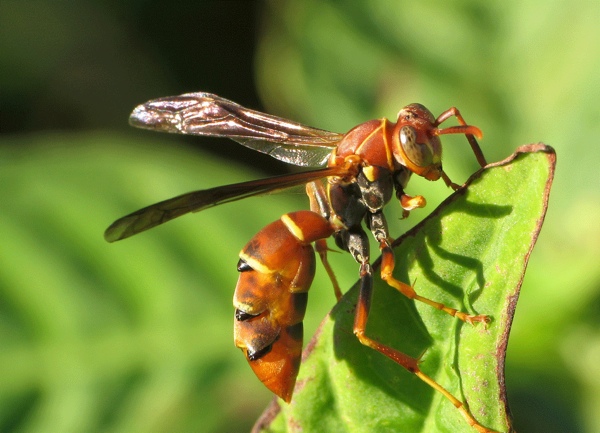
Parasite: Strepsiptera Myrmecolacidae
Strepsiptera insects might not be the cruelest parasites on this list, but they’re definitely one of the strangest. There are 600 species of this little fly, and different species each have their own preferred host. For one family, the Myrmecolacidae, one host isn’t enough—females live in grasshoppers or crickets, and males live in ants.
Females first: When a female finds a suitable grasshopper, she will latch onto it and begin slathering it with enzymes that burn a hole through the grasshopper’s abdomen. Then she climbs into the grasshopper and secretes another enzyme that actually changes the host’s mtDNA, forcing the grasshopper’s body to generate a sac from its own tissue that will protect the parasite from antibodies. During the entire process, the female lives with her head sticking out of the grasshopper’s abdomen, releasing pheromones to attract a male. The grasshopper continues with its life, unaware that a full 90% of its abdomen is now something else.
Male Myrmecolacidae larvae, on the other hand, live in ants. Infected ants will leave their colonies and stumble around while the larva grows and, when it’s ready, the larva will force the ant to the top of a blade of grass and emerge as a winged adult. Then it will fly around and look for a female to impregnate. What’s weird about these flies (as if everything else wasn’t weird), is that they have mouths, but the pieces don’t work—males never eat. They live approximately two hours, just long enough to mate before they die.

Parasite: Ophiocordyceps unilateralis
We covered this particular ant in the first article (the link is in the intro), but we’ve discovered a new degree of specialization in the ophiocordyceps fungus that attacks it, so it deserves another mention. As it turns out, this isn’t just happening in one ant species—the same process occurs in at least four separate species of carpenter ant, probably more. And what’s so fascinating about it is that each ant species has its own species of fungus that preys exclusively on it, even when they all live in the same vicinity.
Understandably, researchers have been extremely interested in the ant-fungus relationship for years. The fungus spores will infect an ant, and then force it to climb onto a tree, bite down on a leaf, and die. A few days later, a mushroom will sprout from the back of the zombie ant’s head in a perfect position to rain more spores down onto the forest floor.
And it gets even crazier, because the healthy ants have further adapted to recognize when an ant is infected. In 2009, a team of researchers in Thailand discovered that zombie ants would invariably go to die in the same areas, places they dubbed “graveyards.” They would find dozens of dead ants clustered around these spots, and oddly enough, out of the 2243 ant carcasses they found, there were only two live ants anywhere near the graveyards, showing that healthy ants were specifically avoiding those regions.
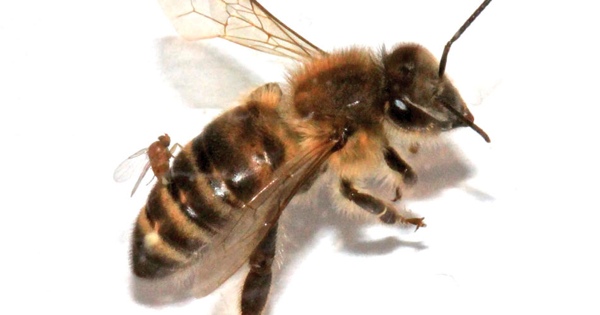
Parasite: Apocephalus borealis
In 2006, bees started disappearing. Known as colony collapse disorder, millions of bees have since either died or mysteriously disappeared, but now scientists think they know why it’s happening. And since it’s on this list, it can only be one thing: deadly mind-controlling parasites.
Researchers first began to notice the parasites in 2012 in areas throughout Northern California and Washington state. The culprit: Apocephalus borealis, or phorid flies. The fly will land on a bee and inject eggs into the bee’s abdomen. When the eggs hatch, the bee begins to go crazy, flying in random circles and stumbling when it tries to walk. These “zombees,” as they’re called, will then leave the hive in the middle of the night, fly a short distance away, and nose dive into the ground. A week later, about a dozen fly larvae will rip their way out of the bee corpse.
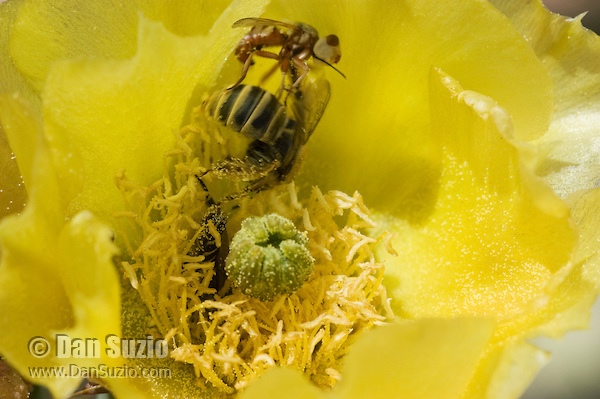
Parasite: Conopidae larvae
As it turns out, bees seem to make pretty good hosts for malicious insect puppet masters. Conopid flies live in Canada and Europe and prey on several different insects, most notably bumblebees. And they’re vicious—not only do they eat the bee alive from the inside, they force it to dig its own grave first.
It starts with infection: a conopid fly will land on the bumblebee’s back and quickly inject it with a harpoon-shaped egg. When the larva hatches it begins to feed on the inside of the bumblebee, forcing it to behave more and more erratically as its internal organs vanish. After 10 entire days of this, the larva will force the bumblebee to the ground, where the bee will attempt to bury itself. The most likely reason for this is protection, because the larva then lives inside the empty bumblebee husk as a pupa until it emerges as an adult fly.
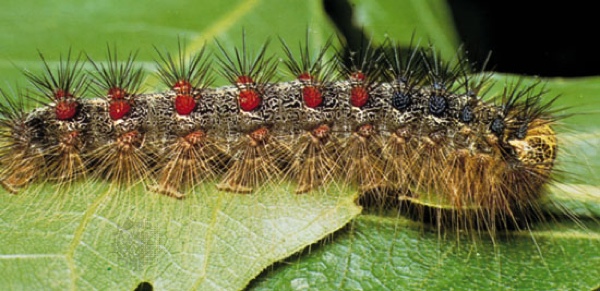
Parasite: Baculovirus
Parasites use some nefarious tricks to control their hosts, but nothing says cruel and unusual like forcing your host to completely disintegrate into a gooey liquid. Even for a parasite, that’s harsh. That’s probably why the gypsy moth caterpillar’s worst enemy isn’t a parasite at all—it’s a virus. The baculovirus affects invertebrates like caterpillars and, with a gene called EGT, takes over their hosts’ brains and forces them to climb into the treetops.
At the top of the tree, the caterpillar stops and waits while, inside, the virus is hard at work converting the caterpillar’s tissue into more virus material. The transformation causes the zombified caterpillar to literally melt where it sits. The liquefied virus then drips down onto the tree’s leaves, which will soon be eaten by other caterpillars.

Parasite: Hz-2v virus
On the lighter side of viral mind control, the Hz-2v virus does something strange to Helicoverpa zea moths, commonly known as corn earworms—it forces them to mate incessantly. Because the virus is sexually transmitted, it needs hosts that propagate fairly quickly so it can spread. But it’s not content with letting nature take its course, so it disrupts the pheromone production centers in female moths, forcing them to release up to seven times more pheromones than normal moths. And in the animal world, pheromones mean sex—in a 2005 study, females with the virus would begin calling out for a mate as soon as they finished mating with another male, doubling the number of partners they came in contact with.
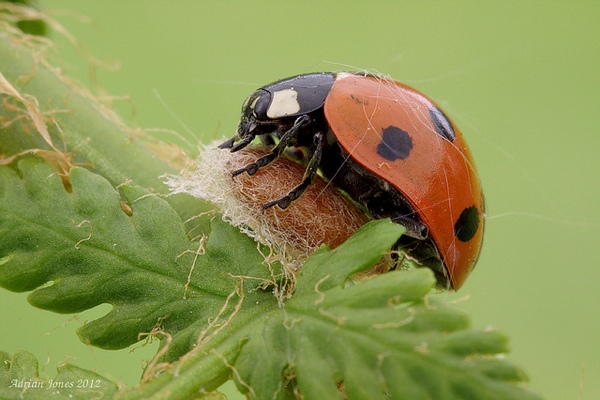
Parasite: Dinocampus coccinellae
Ladybugs (or ladybirds outside the US) are distinctive for their bright red shells and black spots. As you might know, the bright colors are a defense mechanism, letting predators know that it’s probably poisonous, or at least not very tasty. And that’s exactly why dinocampus coccinellae wasps choose ladybugs to guard their young.
When an adult wasp finds a suitable ladybug, it will land, bend its stinger underneath the beetle, and implant a single egg in the ladybug’s belly. After about five days, the wasp larva will hatch and eat any ladybug larvae that might already be inside the host. Then, it will hook into the ladybug like a life support system, absorbing nutrients directly from its body (the ladybug is still moving around and eating at this point).
The wasp larva will live like this for up to a month, but after enough time has passed it slices the nerves that go to the ladybug’s legs, paralyzing it, then digs out through its belly and builds a cocoon between the ladybug’s legs. But it doesn’t kill the ladybug, not yet, because it still needs protection. So it manipulates the ladybug into sitting still, but moving and twitching slightly—just enough to let predators know it’s still alive. After 6-9 days, the fully grown wasp emerges. If the ladybug managed to stay alive for the almost 40 days it was under the control of the wasp, it’s free to go on its way.








